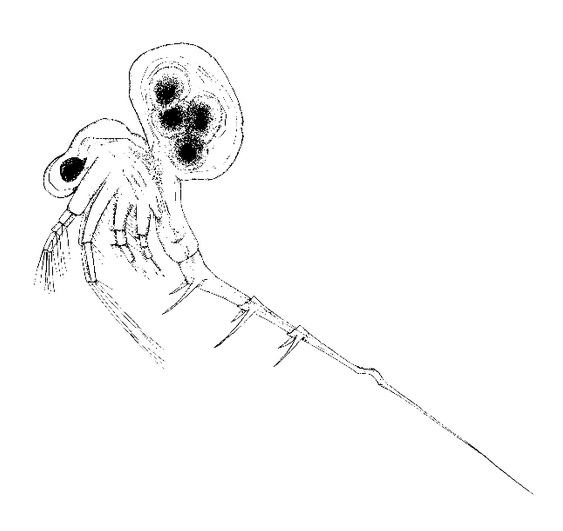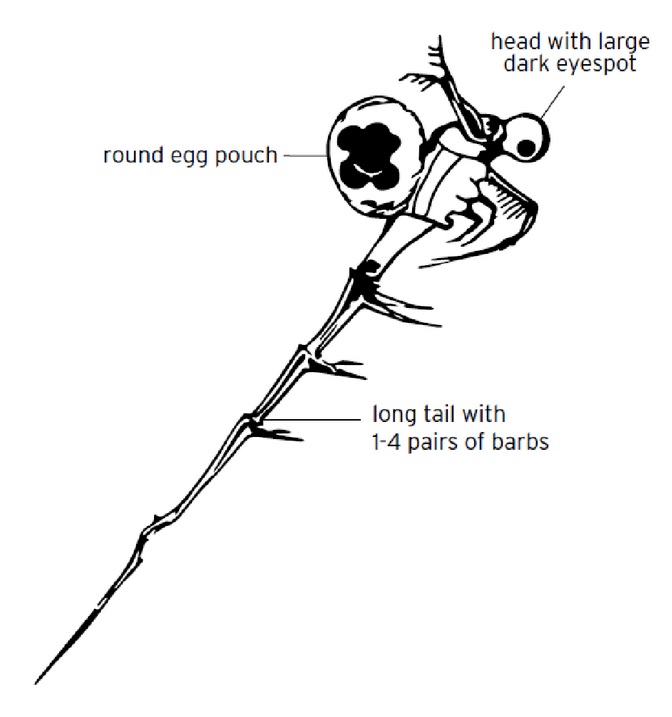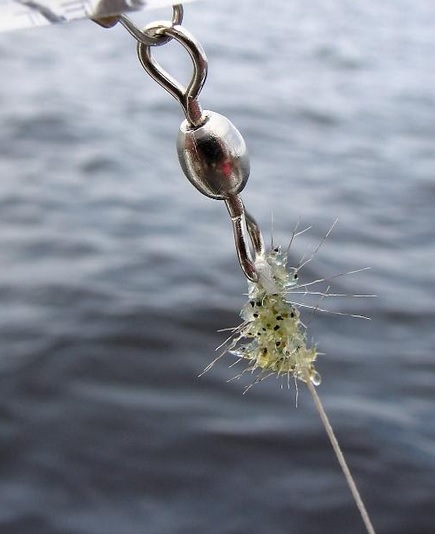 |
Aquatic Invasive Species

Spiny Waterflea (Bythotrephes longimanus)
What is a Spiny Waterflea?
Spiny Waterflea (Figure 1.) is a small freshwater invertebrate not native to North America. They are native to Europe and Asia.

Figure 1. Drawing of a female Spiny Waterflea with an egg sack in its back (not to scale). Drawing courtesy of the Minnesota Sea Grant
Why are they an issue?
Spiny Waterflea are a concern to Manitoba because:
- they can consume large quantities of zooplankton which are a vital part of the food chain and the food source for many commercially and recreationally important fish species
- they can invade new areas quickly and multiply rapidly
- a female can reproduce both sexually, and asexually by cloning. Thus, a single Spiny Waterflea can start a new invasion in a water body
-
their long barbed tails can get:
- entangled on fishing lines, downrigger cables and nets
- stuck in the throat of the small-bodied fish trying to consume them preventing them from swallowing
- they produce eggs resistant to drying that can remain dormant for long periods of time (e.g., decades) until conditions improve. Their eggs can survive a fish's digestive system and thus can be moved to new areas, in bait, for example
-
both the eggs and the Spiny Waterflea themselves can be transported to new water bodies by:
- interconnected water ways
- human activities. For example Spiny Waterflea can be transported in standing water in watercraft (e.g., live-wells) or water-related equipment (e.g., bait bucket) or become entangled on fishing gear
- once established, they are costly to eradicate
Prohibition
Spiny Waterflea are designated as an aquatic invasive species (AIS) in Manitoba.
In Manitoba, it is illegal to:
- possess a member of an AIS in Manitoba
- bring a member of an AIS into Manitoba or cause it to be brought into Manitoba
- deposit or release a member of an AIS in Manitoba or cause it to be deposited or released in Manitoba
- transport a member of an AIS in Manitoba
Where are Spiny Waterflea found in Manitoba?
Spiny Waterflea have been detected in:
- Lake of the Woods (the Manitoba (i.e., Buffalo Bay) and Ontario portions) in 1995
-
Winnipeg River in 2009 (Manitoba portion)
-
Lake Winnipeg in 2011
- the lower reaches of the Nelson River (i.e. Playgreen Lake) in 2014
- Shoal Lake in southeastern Manitoba / northwestern Ontario in 2018
- the portion of the Saskatchewan River east of Cedar Lake to where it drains into Lake Winnipeg in 2020
- Cedar Lake (i.e. Easterville Harbour) in 2020
-
Walker Lake (flows into Cross Lake/Nelson River) in 2022
-
Foot Print Lake (located immediately north of Cedar Lake; Central Manitoba) in 2022
Distribution of Spiny Waterflea in Manitoba
A Spiny Waterflea distribution map of can be found here.
How did Spiny Waterflea get to Manitoba?
Spiny Waterflea were initially introduced into North America into the Great Lakes through the discharge of contaminated cargo ship ballast water in 1982.
Since the initial introduction in the Great Lakes, human-induced movement has allowed Spiny Waterflea to expand to other water bodies, such as Lake of the Woods, Ontario, by movement of uncleaned watercraft and water-related equipment.
Spiny Waterflea entered the Manitoban portion of the Winnipeg River in 2009.
How to Identify Spiny Waterflea?
Spiny Waterflea can be identified (Figure 2) by their:
- small size; 1-1.2 cm (almost 1/2 in.) in length
- single, long tail with 1 to 4 pairs of barbs which makes up 60 to 80% of its body length
- opaque body
- single, large dark eye spot on head
- four pairs of legs
- branched antennae
- round egg pouch on back of females with possible darker-coloured eggs inside
- collect in jelly-like masses on e.g., fishing lines; clusters look like tiny straight pins with dark dots (Figure 3)

Figure 2. A drawing of a Spiny Waterflea showing the main identification characteristics. Not to scale.

Figure 3. A jelly-like mass of Spiny Waterflea entangled on a downrigger cable with noticeable pin-like projections and dark spots.
Credit: J. Gunderson, MN Sea Grant
How to stop the spread of Spiny Waterflea in Manitoba
The most effective prevention is to stop the human-caused movement, introduction and spread of Spiny Waterflea. All surface water-users play a role in preventing the introduction and spread of Spiny Waterflea. Prevention is our best defense.
Spiny Waterflea can be present in surface water originating from an invaded water body. Since they are small and often difficult to see, they can be moved unknowingly to new water bodies via surface water transported, in undrained bait containers and watercraft bilge or live wells. As well, their barbed-tails can become entangled on ropes, nets and other water-related equipment.
The AIS Open-water Season and Winter (Ice-covered) Season checklists are step-by-step resources that can help you prevent the spread of Spiny Waterflea and comply with the Manitoba government's AIS Regulation.
Set fines for AIS offences are in effect year-round.
What should you do if you see an AIS such as Spiny Waterflea?
If you see a Spiny Waterflea in a water body where they are not known to exist, or where an AIS Control Zone has not been established to prevent the spread of Spiny Waterflea, note the location, take pictures and report to the Manitoba government's AIS Unit by:
- emailing AIS@gov.mb.ca
- calling 1-877-867-2470
UPDATED June 2023